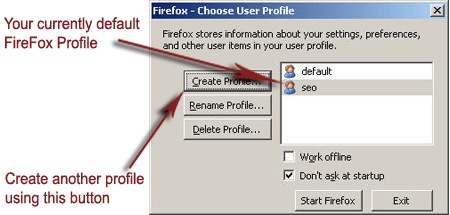
- #Working with firefox profile manager install
- #Working with firefox profile manager full
- #Working with firefox profile manager windows
SeaMonkey 1.x is the successor to the original Mozilla Suite and stores the profile in the same location (which was also used by Netscape 7, a branded version of Mozilla Suite). This can be useful if you are having problems with your Mozilla application, since most problems are in the profile and it's often easier to create a new profile and copy over desired data than to fix the original profile. You can also use the Profile Manager to create an additional user profile on the same computer and both profiles will be available. You can transfer your data and settings to the "default" profile on another computer. Normally, you only need a single profile, the original "default" profile that was created when you first installed your Mozilla application. For profile folder location and a detailed description of contents, read Profile folder - SeaMonkey. (If you’re interested in doing this manually, see the Opera Browser Wiki for instructions.Mozilla applications store your user data such as bookmarks, passwords, mail, and settings, in a profile folder, separate from the program. ini files by hand and launching opera with a /settings command-line switch. Unfortunately, this must be achieved by editing Opera’s. You can have multiple Opera instances running at the same time, each with their own profile.
#Working with firefox profile manager windows
If completely separate IE profiles are important to you, you could create a new Windows user account and switch between them. Internet Explorer doesn’t appear to like the “Runas” tool built into Windows, which allows you to run a program as another Windows user account and see it on your desktop. This means you can use this feature to log into multiple accounts on the same website, just as the profile features allow you to in Chrome and Firefox. The new browser window will share your favorites, history, and other settings, but it will have its own separate cookies.

To use this feature, press the Alt key to reveal the hidden menu bar, click File, and select New Session.

However, it does have a feature that can be used to create browser windows with their own separate cookies. Internet Explorer doesn’t allow you to use separate browser profiles.
#Working with firefox profile manager install
To easily switch between multiple Firefox profiles, you may want to install the ProfileSwitcher extension. (If Firefox is already running, close it completely and launch it with -no-remote.) You can add the -no-remote option to your Firefox shortcuts to make this easier. You’ll need to use the -no-remote option to launch each Firefox instance. For example, to launch Firefox’s Profile Manager with the -no-remote switch, use the following command: To have multiple Firefox profiles running at the same time, you’ll need to launch Firefox with the -no-remote switch.

If you would like to be prompted to choose a profile every time you start Firefox, uncheck the Don’t ask at startup option.įirefox only allows you to run a single browser profile at a time by default. Use the Create Profile button to create new browser profiles. “C:\Program Files\Mozilla Firefox\firefox.exe” -p On 32-bit Windows systems, enter this line instead: “C:\Program Files (x86)\Mozilla Firefox\firefox.exe” -p On 64-bit Windows systems, use the following line:
#Working with firefox profile manager full
(If this doesn’t work, you may need to enter the full path to Firefox instead. With Firefox closed, press the Windows key to open the Start menu (or Start screen on Windows 8), type the following line, and press Enter:


 0 kommentar(er)
0 kommentar(er)
